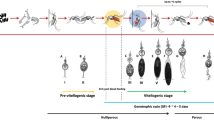Abstract
The international trade of lucky bamboo (Dracaena sanderiana [Asparagaceae]) is responsible for certain introductions of the exotic species Aedes albopictus (Skuse) in California and the Netherlands. Understanding the association of this species with lucky bamboo and other ornamental plants is important from a public health standpoint. The aim of this study was to investigate the importance of indoor ornamental plants as sugar sources for adult A. albopictus. If exposed to D. sanderiana, bromeliad (Guzmania spp. hybrid [Bromeliaceae]), Moses-in-the-cradle (Rhoeo spathacea [Commelinaceae]), 10 % sucrose solution, and a negative water control as the only nutrient source, adult female A. albopictus mean survival time was 12, 7, 6, 15, and 4 days, respectively. Mean survival times for adult males were not significantly different (P > 0.05) from the females and were 10, 7, 6, 14, and 3 days, respectively. Combined male and female survival times were not significantly different on lucky bamboo compared to survival times on a 10 % sucrose control. Based on our findings, A. albopictus can readily survive long enough to complete a gonotrophic cycle and potentially complete the extrinsic incubation period for many arboviruses when only provided access to lucky bamboo plants or possibly other common ornamentals. Vector control professionals should be aware of potential in-home infestations and public health concerns associated with mosquito breeding and plant tissue feeding on ornamental plants.

Similar content being viewed by others
References
Beier JC, Müller GC, Gu W, Arheart KL, Schlein Y (2012) Attractive toxic sugar bait (ATSB) methods decimate populations of Anopheles malaria vectors in arid environments regardless of the local availability of favored sugar-source blossoms. Malaria J 11:31, www.malariajournal.com/content/11/1/31
Braks MAH, Julian SA, Lounibos LP (2006) Superior reproductive success on human blood without sugar is not limited to highly anthropophilic mosquito species. Med Vet Entomol 21:53–59
Dieng H, Saifur RGM, Hassan AA, Salmah MRC, Boots M, Satho T, Jaal Z, AbuBakar S (2010) Indoor-breeding of Aedes albopictus in northern peninsular Malaysia and its potential epidemiological implications. PLoS One 5:e117990
Foster WA (1995) Mosquito sugar feeding and reproductive energetics. Ann Review Entomol 40:443–440
Graham AS, Pruszynski CA, Hribar LJ, DeMay DJ, Hartley AE, Fussell EM, Michael SF, Isern S (2011) Mosquito-associated dengue virus, Key West, Florida, USA, 2010. Emerg Infect Dis 17(11):2074–2075
Impoinvil DE, Kongere JO, Foster WA, Njiru BN, Killeen GF, Githure JI, Beier JC, Hassanali A, Knols BGJ (2004) Feeding and survival of the malaria vector Anopheles gambiae on plants growing in Kenya. Med Vet Entomol 18:108–115
Madon MB, Mulla MS, Shaw MW, Kluh S, Hazelrigg JE (2002) Aedes albopictus (Skuse) introduction into southern California and potential for its establishment. J Vect Ecolo 27:149–154
Manda H, Gouagna LC, Foster WA, Jackson RR, Beier JC, Githure JI, Hassanali A (2007) Effect of discriminative plant-sugar feeding on the survival and fecundity of Anopheles gambiae. Malaria J 6:113, http://www.malariajournal.com/content/6/1/113
Mullen G, Durden L (2003) Medical and veterinary entomology. Elsevier, San Diego, CA
Müller GC, Schlein Y (2005) Plant tissues: the frugal diet of mosquitoes in adverse conditions. Med Vet Entomol 19:413–422
Müller GC, Kravchenko VD, Schlein Y (2008) Decline of Anopheles sergentii and Aedes caspius populations following presentation of attractive, toxic (Spinosad) sugar bait stations in an oasis. J of Am Mosq 24:147–149
Müller GC, Xue RD, Schlein Y (2010) Seed pods of the carob tree Ceratonia siliqua are a favored sugar source for the mosquito Aedes albopictus in coastal Israel. Acta Trop 116:235–239
Müller GC, Xue RD, Schlein Y (2011) Differential attraction of Aedes albopictus in the field to flowers, fruits, and honeydew. Acta Trop 118:45–49
Nasci RS (1995) Control of Aedes albopictus from the perspective of North America. Parassitologia 37:123–127
Qualls WA, Xue RD, Revay EE, Allan SA, Müller GC (2012) Implications for operational control of adult mosquito production in cisterns and wells in St. Augustine, FL using attractive sugar baits. Acta Trop 124:158–161
Scholte EJ, Jacobs F, Linton YM, Dijkstra E, Fransen J, Takken W (2007) First record of Aedes (Stegomyia) albopictus in the Netherlands. European Mosq Bull 22:5–9
Schlein Y, Müller GC (1995) Assessment of plant tissue by sand flies (Diptera: Psychodidae) and mosquitoes (Diptera: Culicidae). J Med Entomol 32:882–887
Schlein Y, Müller GC (2008) An approach to mosquito control: using the dominant attraction of flowering Tarmax jordanis trees against Culex pipiens. J Med Entomol 45:384–390
Sumanochitrapon W, Daniel S, Sithiprasana R, Kittayapong P, Innis BL (1998) Effect of size and geographic origin of Aedes aegypti on oral infection with dengue virus-2. AmJTrop Med Hyg 58:283–286
Townson H, Nathan R, Zaim M, Guillet P, Manga L (2005) Exploiting the potential of vector control for disease prevention. Bull WHO 83:942–947
World Health Organization (2012) Handbook for integrated vector management. WHO Library Cataloguing-in-Publication Data
Xue RD, Ali A, Barnard DR (2008) Host species diversity and post-blood feeding carbohydrate availability enhance survival of females and fecundity in Aedes albopictus (Diptera: Culicidae). J Exp Parasitol 119:225–228
Xue RD, Barnard DR, Müller GC (2010) Effects of body size and nutritional regimen on survival in adult Aedes albopictus (Diptera: Culicidae). J Med Entomol 47:778–782
Yuval B (1992) The other habit: sugar feeding by mosquitoes. Bulletin Soc Vect Ecol 17:150–156
Acknowledgments
The authors wish to thank Joseph Rooney, the bright intern that worked on this project, and the team of the St. Augustine Mosquito Control District. The project was sponsored by the Anastasia Mosquito Control District, 500 Old Beach Road, St. Augustine, FL, 32080, Telephone: 1-904-471-3107, Fax: 1-904-471-3189.
Author information
Authors and Affiliations
Corresponding author
Rights and permissions
About this article
Cite this article
Qualls, W.A., Xue, R.D., Beier, J.C. et al. Survivorship of adult Aedes albopictus (Diptera: Culicidae) feeding on indoor ornamental plants with no inflorescence. Parasitol Res 112, 2313–2318 (2013). https://doi.org/10.1007/s00436-013-3396-1
Received:
Accepted:
Published:
Issue Date:
DOI: https://doi.org/10.1007/s00436-013-3396-1




